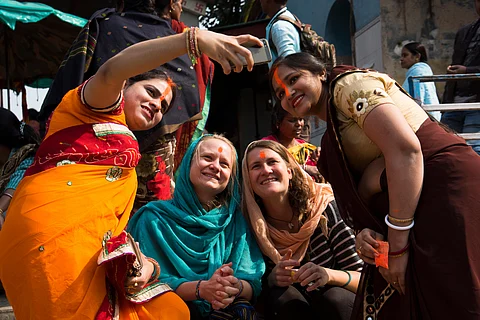
- Destinations
- Experiences
- Stay
- What's new
- Celebrating People
- Responsible Tourism
- CampaignsCampaigns
- SubscribeSubscribe
- Buy Now

The last three months have been a whirlwind for the Indian tourism industry and travellers from the country planning trips overseas.
On April 22, a group of armed gunmen killed 26 civilians in Pahalgam, a hill station in Jammu and Kashmir. Then on May 7, India launched “Operation Sindoor,” sending missiles into terrorism-related infrastructure in Pakistan. Many airports in North and West India closed, with flights re-routed to other cities.
The next month on June 12, an Air India flight from Ahmedabad to London Gatwick Airport crashed less than a minute after take-off, killing 270 people in the process. An investigation into the cause of the crash is ongoing.
Just a day later after the tragedy, the Iran-Israel conflict began, bringing with it airspace closures across the Middle East and the disruption of Air India and other international flights between India, Europe and North America.
Finally, on June 16, the United States government issued a Level 2 travel advisory to India, urging its citizens to “exercise increased caution” due to concerns over crime and terrorism. In particular, the advisory warns women against travelling alone, and highlights several regions where American citizens should take extra precautions, especially in areas like Jammu and Kashmir, along the India-Pakistan border, and the stretch from eastern Maharashtra and northern Telangana through western West Bengal.
Will these incidents affect India’s travel and tourism industry, a sector which contributed INR 21 trillion to the country’s economy in 2024? Outlook Traveller spoke to Madan Bezbaruah, the current secretary general of the Hotel Association of India and a former secretary at the Ministry of Tourism, to understand how the geopolitical situation in the Middle East and domestic uncertainties could play into the recovery of the travel and tourism industry.
The facts show that India is an enviable tourist destination for global travellers.
According to the World Travel and Tourism Council (WTTC), international visitor spend in India reached a record INR 3.1 trillion in 2024, nine per cent above the previous peak of 2019. While domestic travel has remained a vital force, with spending soaring to INR 15.5 trillion (22 per cent above 2019 levels), the revival of international tourism is now propelling the sector into a bold new era of growth.
India recorded 9.52 million Foreign Tourist Arrivals (FTAs) in 2023, the last year for which figures are available. This was close to the 2019 level (10.93 million FTAs), the last year before the COVID-19 pandemic brought tourism globally to a halt. India counts international tourists and foreign tourists separately: the former category includes non-resident Indians (NRIs), while the latter only pertains to those with a foreign passport.
According to Bezbaruah, the global uncertainty, coupled with the Pahalgam attacks and the Air India crash, will have some impact on foreign tourist arrivals in the current year. But he remains optimistic.
“[International tourism to India this year] depends on what happens in the Middle East, the Israel situation and what happens in Europe, as people have doubts about travelling. So I think it will depend on the next month or so [of] how things settle down,” he says.
“Tourism has always bounced back. That is why we must prepare ourselves in the sense that the government of India has to decide what is the right time to launch an aggressive marketing [campaign promoting] India.
“At this moment things may not be very, very conducive but the government will have to decide on a quick assessment of geopolitical factors on whether it is the right time to market India or not and the right way to do that.”
The June 16 US advisory was particularly “unjustified,” Bezbaruah says, due to it not being “supported by the circumstances or the facts here.” He points to the fact that Meghalaya, a state in the northeast of India, was among the places where American staff need approval before venturing outside its capital city of Shillong.
“Meghalaya is one the most peaceful places in India,” he says. “Maybe [the American government] have confused it with Manipur, which has some problems. Apart from that, normal law-and-order incidents take place everywhere in the world. Even in the USA, daily, there are cases of crime. But that doesn’t justify that people should be advised not to travel to the USA.”
“We have to do a lot of marketing to remove this misconception. It will be essential [from a diplomatic viewpoint] to remove this advisory from the US.”
In terms of domestic tourism, Bezbaruah says the Pahalgam attacks were a temporary setback for tourism to Jammu and Kashmir, but that the rest of the country will be unaffected by the events in Pahalgam and Ahmedabad. Last week, the Union Minister of Tourism, Gajendra Singh Shekhawat, met with the Chief Minister of Jammu and Kashmir, Omar Abdullah, on how to revive tourism in the union territory.
Overall, Bezbaruah is keen to encourage international tourists to put aside their hesitations about travelling to India.
“India’s advantages are primarily in business travel and its economic progress, [which] has been attracting attention,” he says.
“[A visit to India] offers a great opportunity to see how democracy in India works, in spite of the diversity. India’s message is that in this world of conflict because of diverse interests, we are a country which has progressed taking its diversity as its strength.”
